The Ultimate Guide to Customer Journey Mapping [Updated 2022]
![The Ultimate Guide to Customer Journey Mapping [Updated 2022]](/_astro/photo-1584652868574-0669f4292976.69af96b6_1RXYuN.jpg)
Table of Contents
In a world full of choice, how are brands standing out?
By creating exceptional customer experiences.
Emotions play a large role in purchasing decisions. Brands that can create positive experiences are more likely to attract and retain customers, drive revenue, and experience growth.
For many businesses, customer journey mapping (CJM) is the first step towards creating these exceptional customer experiences.
We’ll talk about what customer journey mapping is, why customer journey mapping is especially important for offline-first businesses, and how to create your own customer journey map..

Customer journey mapping process, source: Unsplash
Customer journey definition
Your customer journey is the series of touchpoints your customer experiences as they interact with your brand on their way to making a purchase or after purchasing.
What is customer journey mapping?
Customer journey mapping is a visual representation of a customer’s experience with your brand. It highlights the various touchpoints, actions, and goals a user has in the process of becoming your customer.
Since 56% of customer interactions happen across channels, there are many opportunities for cost savings, growth, and customer retention for your brand when you deepen your understanding of your customer’s journey. It’s best practice to map out your customer journey so you can identify pain points and opportunities for growth.
A customer journey map is a visual representation of your customer journey from the moment they first interact with your brand all the way through to when they become loyal advocates.
Customer journey mapping will help you step into your customers’ shoes and gain valuable insights into their real-world interactions with your brand – from clicking on your Google ad to stepping into your museum or store.
A strong customer journey map will provide insights into the aspects of the customer journey that are working well, not-so-well, and any aspects that may be missing altogether. These insights are an incredible resource as they help you to better understand your customers and pinpoint where you should be focusing your time and efforts.
Why is customer journey mapping important?
An exceptional customer experience is essential if you want to build brand equity, attract customers, and grow your business. Your customers interact with your organisation in a variety of ways. With the increasing complexity of interactions online and offline you’d think customer journey mapping features in most organisations’ customer experience (CX) plans.
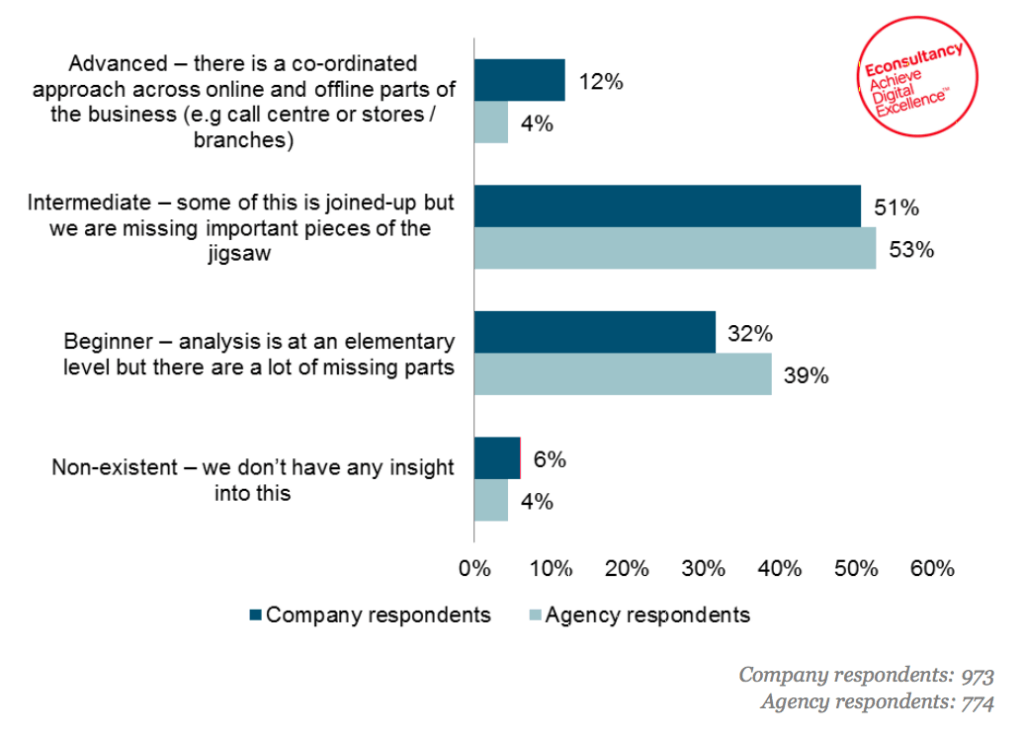
How would you best describe your understanding of the customer journey?
Source: econsultancy.com
Yet, even though 81% of companies believe customer experience is a competitive advantage, only 8% report having a joined up omnichannel strategy. A full 33% admit they’re unable to track customer journeys at all.
It makes sense to spend some time creating your customer journey map – 71% of brands say that customer journey mapping has reduced their customer service costs by up to 20%. A further 77% of consumers say they view brands more favourably when they ask for feedback.
With 84% of consumers saying being treated like an individual is very important to winning their business, it’s critical that you understand your buyers’ desires and pain points at every interaction with your brand.

Source: salesforce.com
To create an exceptional customer experience, you need to have the proper data. Customer journey mapping is a strategic tool that helps you create personalised experiences along every step of the customer journey. It helps you meet short-term customer needs and expectations but also gives you a long-term view of their expectations so you can anticipate future needs. A customer journey map provides you with the insights you need to better understand your customers. This allows you to then create a customer experience that satisfies all their expectations.
The last mile of the customer journey is an important topic and customer journey mapping can help you identify opportunities for advanced forecasting, optimised delivery, intelligent insights, and real-time tracking.
Benefits of customer journey mapping
With information comes empowerment. By gaining a deeper understanding of your customer experiences through customer journey mapping, you will be empowered to make decisions that elevate your business.
By thoroughly mapping customer journeys, you can develop a customer-focused mentality, improve your customer retention rate, and gain a deeper understanding of your customers.
Customer journey mapping has several benefits, including:
- Uncovering the differences in behaviour between buyer personas
- Creating a logical buying process
- Optimising the onboarding process
- Benchmarking your customers’ experience against predictions
You can create a customer-focused mentality throughout the company
Although every department in your company is working towards the same goal, the objectives of each department may be slightly different. Everyone in the business wants to achieve growth. But while the marketing department focuses on building brand awareness, the accounting department focuses on profits and losses. Whatever the department’s objectives may be, the customer must always be at the heart of every action and goal.
By creating a customer journey map that illustrates the entire customer journey and the role each department plays in shaping the experience, you can unite departments over a shared customer-focused mentality. This shared mentality can help departments unite their objectives, improve the customer experience, and reach the same goals.
You can improve your customer retention rate
Customers are largely driven by emotion. If your business delivers a consistently positive experience, your customers are unlikely to take their business elsewhere.
By improving customer engagement and your customer retention rate through exceptional customer experiences, your business will likely also benefit from:
- Increased revenue. You are more likely to up-sell and cross-sell to existing customers. These revenue sources are often more profitable for your business.
- Improved external touchpoints. Your loyal customers will share positive referrals and reviews of your business to new potential customers.
- Cost efficiencies. It is generally more affordable to retain current customers than to attract new ones.
You can gain a deeper understanding of your customer
The best way to help your customer and create an exceptional customer experience is by understanding who they are and what they want. Diving into the actions and touchpoints your customers have along their journey will reveal the different goals they have and the outcomes they expect. This understanding will allow you to implement solutions and strategies that appeal directly to your customer’s wants and needs so you can continue creating those positive experiences and build brand loyalty.
A case against customer journey mapping
While there are many benefits to creating a customer journey map, it is not without its limitations. Some of these limitations include:
Little opportunity for flexibility. If you are a newer business without a pre-established customer journey in place, creating a customer journey map can limit your ability to test and experiment with different customer experience models or initiatives.
Excludes external factors. Inputs such as cost, implementation difficulty, and competition are not included in a customer journey map. However, these inputs have the potential to hold a notable influence on your overall customer experience and customer satisfaction.
Does not consider related journeys. Purchases don’t often happen in isolation, and your customer is likely engaging in a variety of related journeys with multiple businesses at the same time. CJM’s are not able to evaluate how these related journeys impact one another and influence the overall customer experience.
Despite its limitations, a customer journey map is still a great tool. Supplement CJM’s shortcomings by implementing additional tools that can work alongside your map.
The basic concepts of a customer journey map
A customer journey map combines a series of touchpoints, actions, emotions, and barriers that your customer experiences throughout their journey. Together, these inputs create one cohesive experience.

Example Customer Journey Map, source: Columbia Road
A strong journey map will include all these different inputs in detail so that you can make customer experience decisions based on complete and accurate information.
Touchpoints
A touchpoint is any interaction a customer has with your brand. This can include everything from in-store experiences and web searches to paid advertising and word-of-mouth referral. Essentially, a touchpoint is any interaction that allows your customer to form an opinion on your business.
Touchpoints are critical because their combined influence determines whether a user will become a customer. The challenge with touchpoints, however, is that many of them are outside of your control. Peer recommendations and user-generated content cannot be managed by your marketing department and depend upon the experiences of other customers with your brand.
Actions
Actions are any behaviour your customer engages in. This includes following your social media page, visiting your website, or coming to your store. While not all actions are equally important, they all play a role in determining whether a customer makes a purchase at the end of their journey.
Emotions & Motivations
Every customer has a different reason for purchasing from you. It may be because your product or service fulfils a functional need or because the customer aligns with your brand promise. Either way, the aspect uniting all purchasing motivations is emotion.
Customers’ decisions are largely based on how your business makes them feel. Ensuring you can fulfil customer’s functional needs while delivering a positive emotional experience is essential in creating a great customer journey.
Barriers & Pain Points
No customer journey is perfect, and at some point, your customer is likely to come across a barrier or pain point. Maybe your website load time is slow, or your return policy does not meet expectations. Whatever it is, most customer encounters a touchpoint or action that takes away from their overall experience.
Customers experience roadblocks, dead ends and frustration in their journey. The more friction we put in front of potential customers, the less likely they are to complete the journey
To create an outstanding customer experience, the first step is knowing where your barriers are. You need to identify these pain points and understand why they deter customers. With this information you can respond quickly and build effective solutions.
Current State
The most common type of customer journey map, is one that represents your customer journey as it currently exists. These customer journey maps outline the touchpoints, actions, emotions, and barriers that your users currently go through before and after becoming a customer. These types of CJM’s are great to help you acknowledge aspects of the customer journey that are working and identify growth opportunities.
Future State
A future state customer journey map, visualises your customer journey as you would like it to be. Future state CJM’s are aspirational by nature. They are great for creating a visual representation of your customer experience goals.
How do I create a customer journey map?
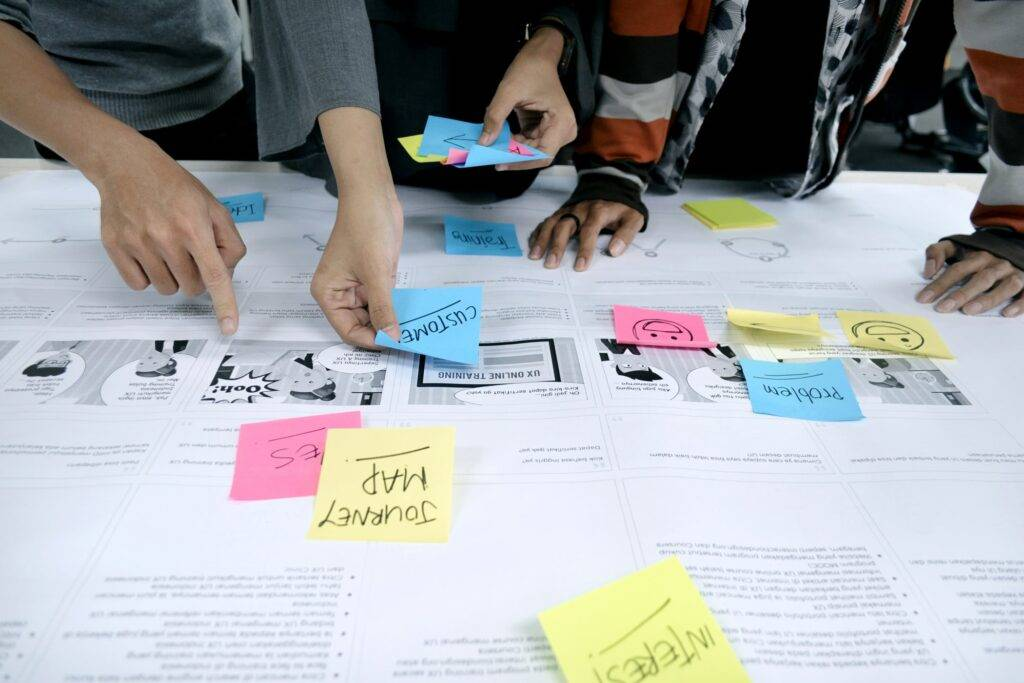
Source: https://unsplash.com/photos/w00FkE6e8zE
Your customer journey mapping should seek to address questions such as:
- Which customer segments am I targeting?
- What kinds of behaviours am I looking at – linear or cyclical?
- How can I start from the customer’s perspective?
- How can I recreate experiences across multiple channels and touch points?
- How can I represent important metrics and indicators such as NPS or CSAT scores?
There are many ways you can go about creating and designing your CJM, but for best results, we recommend following the following customer journey mapping methodology:
Conduct persona research
Many businesses believe they have an in-depth understanding of your customers and the customer experience. Yet, nothing beats speaking to your customers directly. For a strong customer journey map, conduct thorough research. Interview your customers via feedback surveys and questionnaires to get more complete and honest feedback on your current customer experience. Avoid making mistakes when surveying customers.
It is important to note when building your customer journey map, it is often best practice to focus on one customer persona at a time. Your customer base is diverse and so are their experiences with your brand. One CJM will not be enough to cover the variability in different customer journeys. Begin by focusing on one persona and slowly build out more maps from there to cover multiple personas.
Understand your customer’s goals
At every step along the customer journey, there is a goal your customer is trying to achieve. Whether that be trying to find your store hours when visiting your website, or wanting to learn more about your brand personality through social media. Every action is motivated by an end goal. By figuring out what these goals are at each stage of the customer journey, you will be able to determine if these goals are being satisfied effectively. You will also understand how these goals are evolving throughout the customer journey.
List all the touchpoints
The strongest CJM’s have lots of detail and are specific. Spend time identifying all the different touchpoints in your customer journey, to get a complete view of the experience.
Map the current state
To understand how you can improve your customer experience, you must first understand how the current journey is doing. Start by mapping the current state to create a baseline and identify opportunities for growth and improvement.
Take the customer journey yourself
Your real customers will be able to tell you a lot about your current customer experience. But most customers are not taking note of each and every touchpoint. They are likely to forget minor pain points or small moments of delight when questioned later on.
Going through your customer journey yourself is a great exercise. Approach with an unbiased perspective so you can experience first-hand the strengths and limitations of the journey. You’ll find deeper insight when you put yourself in your customer’s shoes.
Chart a sentiment line
Representing the emotional state of your customer throughout each stage of the journey is one of the most important aspects of your customer journey map. Each action taken by your customer is driven by emotion, so understanding how these emotions evolve throughout the journey and how they influence different actions is imperative. Include a sentiment line in your CJM that represents how emotions are evolving throughout the journey, and use this as a baseline when creating changes and improvements to your map.
Step-by-step: Customer journey mapping process
While it can be helpful to find other customer journey mapping examples, your customer journey map will be unique to your organisation’s goals and customers.
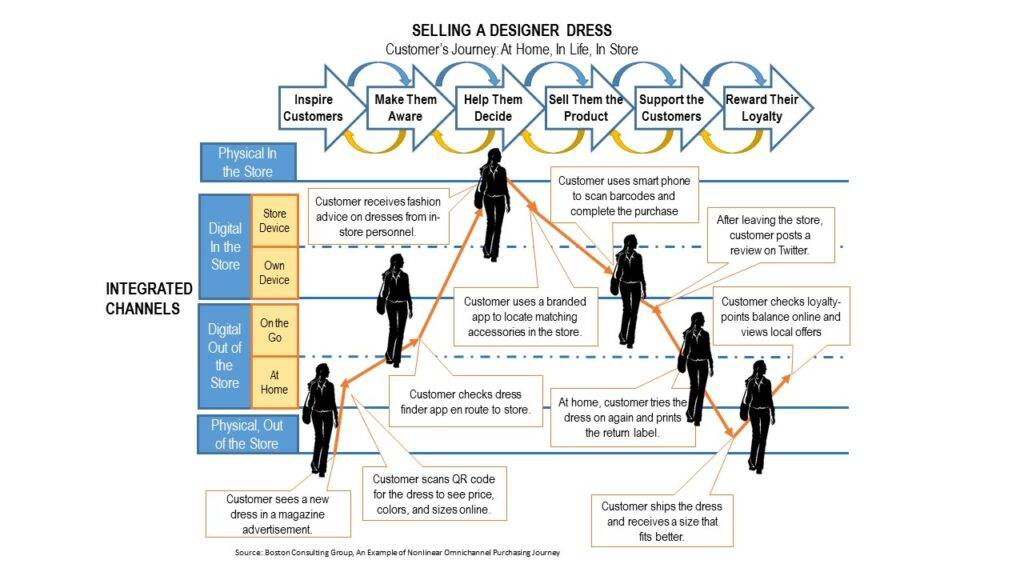
Source: davechaffey.com
We suggest the following 5 step process to build your customer journey map:
1. Gather the support of stakeholders
In the modern connected enterprise every department has a stake in the customer experience, not just customer support. Getting everyone involved early in the customer mapping process will help you define requirements and gather feedback further down the line.
2. Conduct customer research
Find out everything you can about your customers and their pain points through surveys, customer effort scores, and interviews. You can also use the data you have concerning your interactions with your customers, including your Customer Relationship Management (CRM) tool, social media conversations, customer support calls, and complaint logs.
Build a complete picture of your customers using words and phrases you’ve heard them use, adding motivations, expectations, pain points and other emotional elements you’ve been able to gather.
When you’re building a customer journey map, don’t forget to include customers that didn’t purchase to uncover differences in their experiences. This can provide useful insights on their decision-making process, helping you to plug gaps in your product and service offerings you may be unaware of.
3. Create your customer personas
Armed with the results of your customer research, build a comprehensive profile of your customers. You may have one or several buyer personas. A buyer persona is an idealised profile of a customer but it will help you formulate an understanding of each customer type.
Your customer persona will also help you understand your customers’ motivations.
These can be:
- Price – At the research stage
- Information and guidance – At the purchasing stage
- Recognition from peers – Post purchase, such as when recommending your product or service to their friends and family
4. Draw your customer journey map
There are many ways (customer touchpoints) your customer comes into contact with your brand before, during and after purchasing.
Your map should capture these touch points adequately, highlighting those that have the highest impact. The point of sale is especially important for many businesses because this is the last interaction your would-be customer has with the brand before committing to a purchase.
For long customer journeys, break up your map into phases, taking care to document your customers’ mindset throughout each phase as they try to accomplish different goals.
Start with a customer journey map template if you’re unsure where to start. You may want to ask a graphic designer to give your map a professional finish to maximise its impact on stakeholders.
5. Refine your journey maps
Use qualitative and quantitative data to identify roadblocks and pain points in your customer journey. Also, mark areas where you’re excelling so you can build on them. Where there are roadblocks in your customer journey, drill further into the data and try to figure out where adjustments might have the biggest impact.
How can I improve my customer journey?
Once you understand your current customer journey, you will face the challenge of figuring out ways to make improvements. While each business will have different areas of focus, here are some guiding steps to follow when creating and implementing changes.
Set goals
Your journey maps will be extensive, and there are likely many different areas you could focus your time on. To avoid getting overwhelmed or, feeling unsure of where to start, begin by setting specific goals of what you want to achieve. Maybe you want to focus on your social media presence or improve your customer service wait times, whatever it is, start small and set specific and tangible goals to guide your efforts.
Decide what to measure
When making improvements to your customer journey, it’s important to measure their impact. By defining metrics and measuring the success of different initiatives, you can track your progress and create a benchmark for future changes and opportunities.
Include KPIs
Changes to your customer journey won’t happen overnight. Set key performance indicators to help keep your team focused and on track as they work towards implementing outlined improvements. Align your KPI’s with your goals to help keep the improvement process organised and succinct.
Prioritise and fix issues
Once you’ve built your current state customer journey map, there will likely be quite a few customer pain points and improvement opportunities. To decide where to start, prioritise improvements based upon their significance in the customer journey, how frequently a customer interacts with that touchpoint, and the return on investment (ROI) they can deliver. Begin by fixing the highest priority items and work your way down the list.
Review and update each journey map after every major change
As your business evolves, so will your customer journey. Every time you launch a new product, service, or location be sure to update your CJM to reflect the changes. Customers expect a lot and being able to constantly improve your offerings while delivering consistently exceptional experiences will go a long way in building customer loyalty.
Set monthly, quarterly, or annual meetings to review the CJM as a team to help get you in the practice of making updates frequently.
Example customer journey maps
No two customer journey maps are alike. Depending on your industry and who your customers are, your customer journey map will hold different details and nuances to create a comprehensive and specific visual of your customer journey.
Although each CJM is unique, here are a few examples to help get you started.
Retail customer journey map example
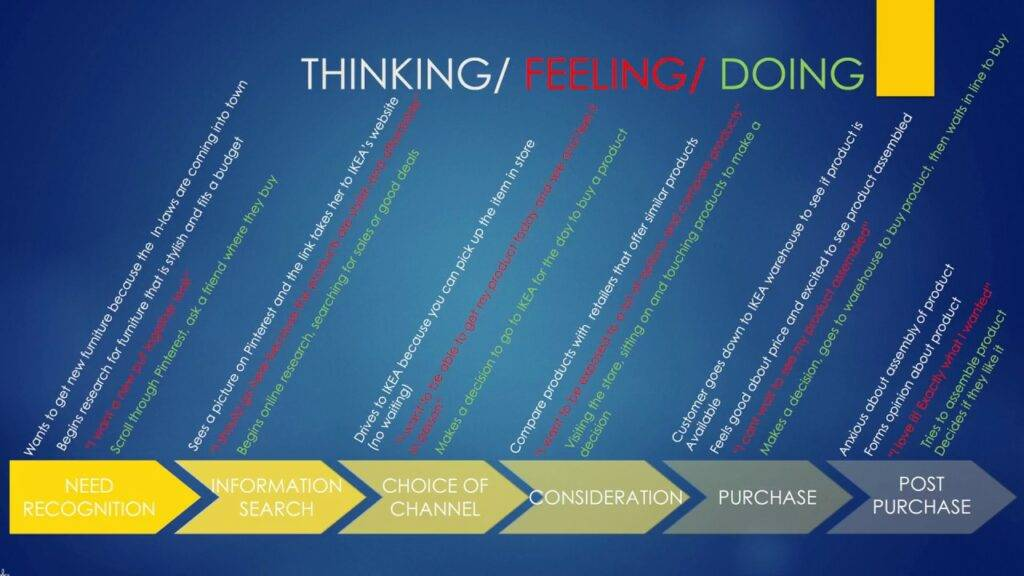
Source: IKEA
Customer journey mapping for big corporations can be tough. Ikea did a great job of developing a CJM that outlines the thoughts, behaviours, and emotions of a customer throughout their journey at the store. Visually appealing and easily digested, this map clearly describes the entire journey with all its complexities and nuances.
Bonus example: Omnichannel consumer journey map example

Source: Medium
It’s not a simple customer journey map, but this amazing graphic beautifully demonstrates how offline and online consumer journeys are connected as a buyer interacts with different touchpoints at IKEA.
B2B customer journey map example

Source: FedEx Business Insights
This customer journey map by FedEx is customer-focused and addresses the goal of the customer – global expansion. Through b2b international customer journey mapping, and by highlighting the customer journey from start to finish - and how FedEx plays a role in goal attainment - FedEx can position itself as an essential aspect of the B2B customer journey.
Circular customer journey map example
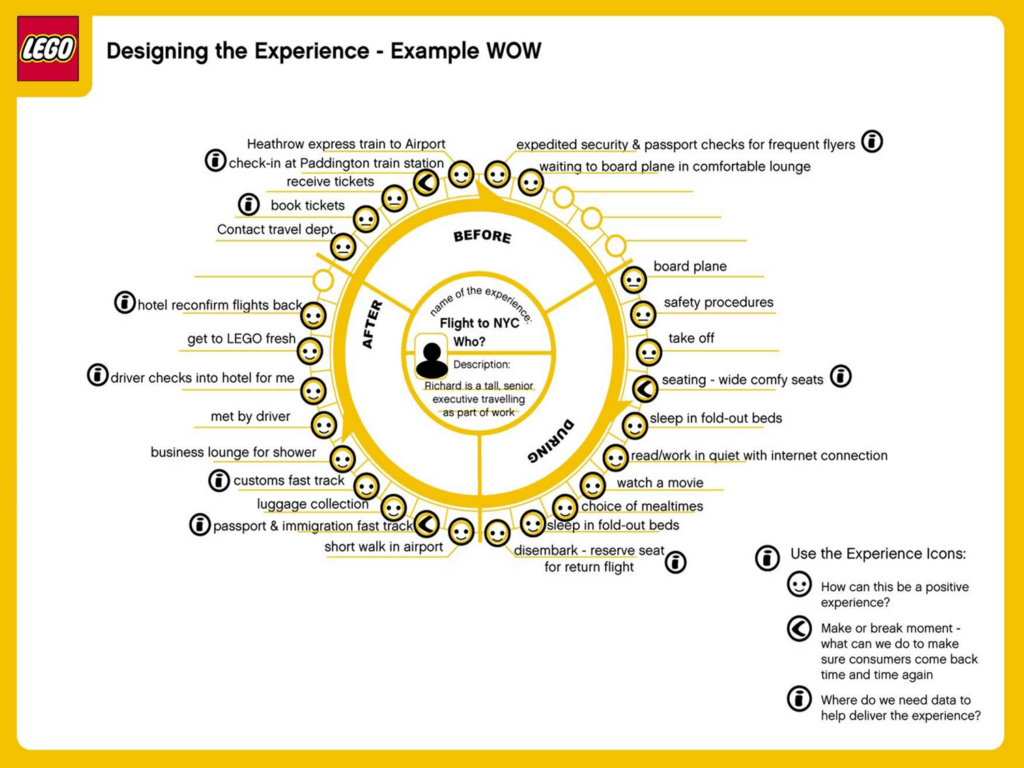
Customer Journey Map created by LEGO
A fun example of a circular customer journey map is the one from Lego, showing the customer experience of a Lego customer flying from Heathrow to New York City. In this example, Lego pays close attention to each step of the journey to create a detailed, unique, and exceptional LEGO customer journey.
Automotive customer journey map example
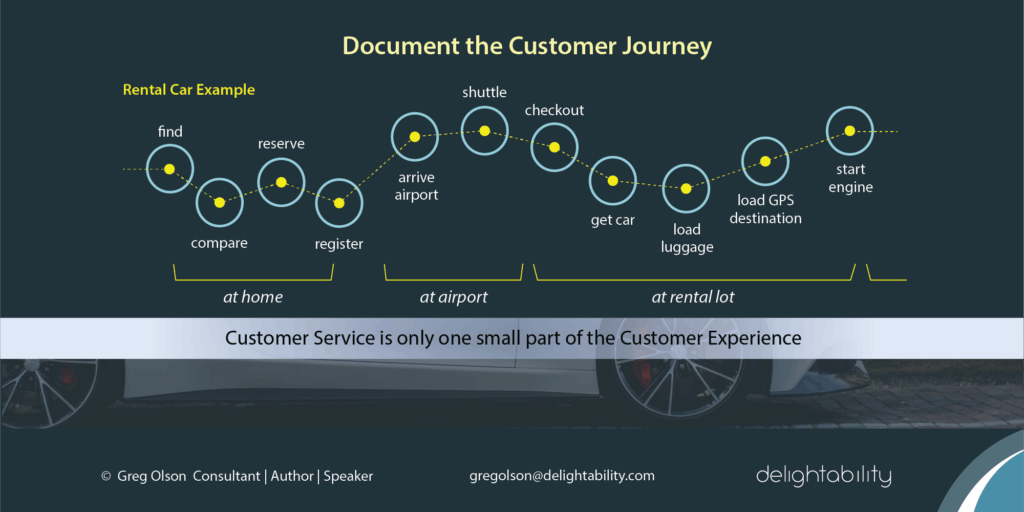
Car Rental Customer Journey Map created by Delightability
The image shows an automotive customer journey map using car rental. It’s taken from Gregory Olson’s book, The Experience Design Blueprint.
As you might notice, the relevance of each touchpoint on the journey depends largely on the audience. The company may have an interest in improving the overall experience when you’re trying to find a car to rent and using their app, but for someone renting a car for business travel, that might be less important than how easy it is to return the car at their destination.
So context matters. How you use the service as a business traveler will likely be very different from how you use it as a tourist.
The one thing we can all relate to is that most people have rented a car, so we can look at this map and think about all of our experiences in this context—and then consider how they could improve those parts that are more relevant to us based on what we do with them.
Use of customer journeys to improve customer satisfaction
Depending on what type of business you are in, the ideal customer experience will be different. By understanding who your customers are, what they need, and the experience they want to have, you can prioritise and implement the improvements that best align with your customer’s ideal experience.
In our world of change, competing on exceptional experiences is key to success. Make sure to use your journey map frequently and across departments to maintain your competitive advantage.
Tools to help you with your journey mapping
There are a variety of tools you can use to support the development of a strong customer journey map. Some of the tools that we recommend include:
Get everything done at once with Smaply.
A great tool to help you along the journey, Smaply helps you create customer personas, stakeholder maps, and customer journey maps. Includes various visualisation features and icons to help you add detail.
Create custom templates with Lucidchart
A great option for those looking to create a customised map. Lucidchart is a free online tool that allows you to develop a customer journey map using its suite of features.
Keep yourself on track with Asana.
After building your map, you will need a strong organisational system to keep you on track to implement journey improvements. Using a CRM journey map or work management platform like Asana helps you build out implementation projects, assign roles, and collaborate with your team to make customer journey changes quickly and efficiently.
15 free customer journey map templates
A customer journey map that looks great and is easily interpreted is more likely to be used by your team. Here are some great (free!) customer journey templates and customer journey canvas you can use to help develop your journey map:
- Practical Service Template
- Customer Journey Canvas
- Visual Paradigm Customer Journey Maps
- Invision App CJM Template
- Shopping & Purchases CJM Template
- Bundled Journey Map
- Graphic Customer Journey Maps
- Retail Customer Journey Template
- Miro Customer Journey Map
- Customize CJM
- Comprehensive CJM Template
- Simple Customer Journey Template
- Leisure & Entertainment CJM Template
- Restaurant Customer Journey Map
- Service Blueprint Template
Download your free customer journey map template using any of the links above.
Final Thoughts
To compete in our world of choice, you need to stand out from the crowd.
By delivering exceptional customer experiences you can stay competitive, build strong customer relationships, and drive profits.
Use the above steps, recommendations, and tools to build a strong customer journey map that will help you better understand your customers and grow your business.

Tom Sutton
Co-founder, TRACX
Tom is the co-founder of TRACX, a no-code marketing platform that allows local business owners to collect customer feedback and create engaging marketing campaigns. With over 17 years of experience in entrepreneurship, product development, and marketing for businesses large and small, Tom is currently responsible for developing product and marketing strategies for TRACX.